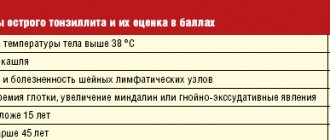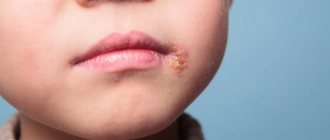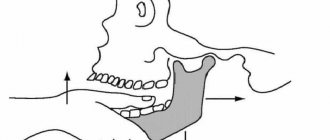Causes of jaw clenching during trismus
- inflammation of the masticatory muscles;
- inflammation of the gums;
- caries;
- abscess;
- inflammation of the periosteum of the lower jaw;
- jaw injuries (cracks, fractures, dislocations);
- dousing with cold water;
- animal or insect bites.
Trismus can also be a consequence of the following diseases:
- osteomyelitis of the jaw;
- periostitis;
- neurosis;
- epilepsy;
- meningitis;
- hysteria;
- arthrosis of the jaw joint;
- cancerous tumors;
- convulsions;
- rabies;
- tetany;
- paralysis;
- tetanus;
- pulpitis in the acute stage, etc.
Attention - facial expressions!
After complex treatment, patients are recommended to use medicated mouth guards at night. They are made individually by the orthodontist. The pads reduce pain in the joint, an unpleasant feeling of heaviness, fatigue in the masticatory muscles, neck muscles, and normalize mouth opening.
In order to prevent this very annoying nuisance from happening again, you need to avoid active conversations while eating, an excited manner of speaking when a person does not notice what is happening with his facial expressions, as well as hypothermia, which can provoke inflammation in the joint, which makes him more prone to to incorrect movements, more vulnerable.
Why does jaw pain occur?
Read more
The main stages of trismus
- third - a person can open his mouth 10 mm, the most difficult stage;
- second - the patient can open his mouth 10-20 mm;
- first - the patient opens his mouth 30-40 mm, respectively.
In all cases, a person should immediately consult a doctor. You may need treatment in a hospital setting. In the process of clenching the jaw, there is a high probability of damage to the gums and chipped teeth. If help is not provided in time, oxygen starvation may occur.
Dental diagnosis of trismus involves:
- visual examination of the patient;
- to unclench the jaw, the dentist injects a drug that relaxes the muscles;
- To make the diagnosis more comfortable for the doctor and patient, an anesthetic drug is also administered;
- In addition to the dentist, you may need to consult a neurologist, surgeon, or traumatologist.
Loaf, loaf
Quite often, cheekbones cramp when yawning if you “overdid it” and opened your mouth too wide. Sometimes the jaw cramps in sleep when the muscles involuntarily contract. There are times when the jaw muscles cramp in completely unexpected situations.
Imagine a magnificent wedding in Slavic traditions. There are hundreds of guests, the tables are laden with dishes, the bride is dressed in a snow-white dress with a flowing veil. Everyone prepared for the event for a long time, thought through all the stages of the celebration, and the toastmaster is actively holding competitions. And one of the main characters - the loaf - is brought out for everyone to see.
According to an ancient custom, the bride and groom each take a bite from the loaf, and the one who grabs the largest piece becomes the head of the family. In our age of emancipation, a woman does not want to yield to a man in anything. The newly-made wife opens her mouth wide to defeat her husband, and suddenly realizes with horror that her jaw is cramped... The action quickly moves to the nearest emergency room. There the bride is given a relaxing massage, and the pain goes away. At this time, the toastmaster masterfully entertains the guests, acting out a scenario for stealing the bride. The story has a happy ending, but friends and relatives will never let the couple forget this story.
How to properly treat trismus of the masticatory muscle?
Treatment of the problem involves:
- immobilization of the jaw by applying a bandage or splint;
- eliminating the underlying cause of trismus (disease or specific condition);
- taking neuropsychic stimulants and sedatives;
- a course of taking muscle relaxants;
- a course of antibiotics (for inflammatory processes);
- physiotherapy;
- peace and release from physical work.
If the patient’s condition is severe, observation in a hospital is necessary under the supervision of a maxillofacial surgeon, neurologist, traumatologist, etc.
After eliminating acute symptoms, a person is recommended a special diet:
- plenty of fluid;
- chopped food;
- vegetables and fruits;
- natural juices.
If it is impossible to eat normally, food is supplied through a tube, and liquid is supplied through the skin.
To restore the functions of the masticatory muscle, the patient is recommended to perform special therapeutic and preventive exercises.
It is important to completely cure trismus, and not just suppress its symptoms. If the cause is not removed, the problem will reoccur. Spasms put a powerful strain on the teeth, gums, and nervous system. It is very important to contact an experienced dentist with a surgical profile, who will help cure the disease and tell you what to do in emergency situations. The 32 Dent network of clinics in Moscow employs specialists who will provide such comprehensive assistance for trismus of the masticatory muscle and other serious problems.
If you have a problem similar to that described in this article, be sure to contact our specialists. Don't diagnose yourself!
Why you should call us now:
- We will answer all your questions in 3 minutes
- Free consultation
- The average work experience of doctors is 12 years
- Convenient location of clinics
Single contact phone number: +7
Make an appointment
Botulinum therapy as one of the methods for treating hypertension and bruxism
Botulinum toxin type A, which is used in medicine and cosmetology, is able to relieve spasms and relax overstrained muscles, specifically reducing their activity or immobilizing them completely. But not forever, but only for a certain period of time - during this time the body adapts to new circumstances and stops overstraining a certain area. That is, the therapeutic effect for a diagnosis such as “bruxism” lasts for a long time, which is confirmed by numerous reviews from patients.
How it works?
Botulinum toxin type A is a neurotoxin produced by the bacteria Clostridium botulinum. It blocks nerve impulses from the central nervous system to muscle fibers. That is, in fact, the drug paralyzes a certain muscle without transmitting motor commands from the brain to it.
In medicine and cosmetology, it is used in ultra-small and highly purified forms - that is, it is not poisonous or toxic to the body!
The drug is injected into clearly defined points in order to affect only a specific muscle and not affect the work of others. The dosages are harmless, and the blocking is reversible. Over time, the drug is completely eliminated from the body - usually this takes from 5 to 7 months. Gradually, neuromuscular conduction in the area is restored, and mobility returns to the muscle - but since it has “rested,” the spasmodic fibers are smoothed out, and the body adapts and normalizes the load.
Botulinum toxin only relieves hypertonicity and allows the muscle to relax. This is the basis of its well-known cosmetic effect - smoothing out wrinkles by blocking the work of facial muscles. That is, it is wrong to think that you can “pump yourself up” with botulinum toxin preparations - they do not in any way increase the volume of soft tissues.
To relieve excess tension in the masticatory muscles, we use the drug Botulax for intramuscular injection with 99% active substance content, thereby increasing the speed of onset and duration of the therapeutic effect. And thanks to the high degree of purification of the drug, the risk of adverse reactions is minimized. The dosage and course are selected by the doctor strictly individually!
How long does it take to cure trismus?
Typically, full muscle recovery can take one to three weeks, depending on the cause of the trismus. More time will be needed for fractures of the jaw, which must heal properly and subsequently develop.
To prevent trismus of the masticatory muscle, you must:
- do not cause diseases of teeth and gums;
- get vaccinated against rabies and tetanus (rabies and, as a result, lockjaw can be fatal);
- In case of blows or damage to the jaw, seek emergency help from dentistry;
- avoid stressful situations, nervous tension;
- when engaging in contact sports, wear special helmets and mouthguards for protection;
- undergo regular preventive examinations with a trusted dentist. These are the doctors who work in the 32 Dent network of clinics, where you will be happy to see you at any time. Contact us!
Disadvantages of treating bruxism with Botulax
It is important to choose an experienced, certified doctor who has trained and has official approval for botulinum toxin injection therapy - this is a rather complex procedure with its own subtleties. If the rules of storage, selection of dosage and administration technique are not followed, complications may occur. And if hematomas, bruises or slight swelling basically go away on their own, then difficulties with swallowing and chewing should be eliminated together with a doctor.
Our doctors have been trained and certified - treating hypertonicity with botulinum therapy in our clinic is completely safe
Recommendations
If this phenomenon occurs against a background of elevated temperature, you should urgently go to the surgeon. This may be an exacerbation, complicated by internal suppuration. The only correct action is surgery.
If the pain is sharp and boring, you will need to be examined by a neurologist. Apparently the trigeminal nerve is affected.
For malocclusions that cause bruxism, the patient will receive real help if the dentist installs splints and dentures. This way you can stop the progression of the disease and prevent it from developing even stronger in the future.
And finally, if the pain is constant, not too sharp and aching, there is a high risk of cancer. It is extremely important to stop its progression in time and begin emergency treatment.
Thus, the main advice is the help of professionals. And the sooner the better.
Diagnostics
Early cases of hemifacial spasm are sometimes difficult to distinguish from facial myokymia, tics or myoclonus, which may be caused by pathological processes in the cerebral cortex or brainstem. In such cases, neurophysiological testing is the most valuable diagnostic method.
Wide and variable synkinesis on eyeblink tests and high-frequency discharges on electromyography (EMG) with associated clinical manifestations are diagnostic criteria for hemifacial spasm. Stimulation of one branch of the facial nerve can spread and cause a response in the muscle innervated by another branch. Synkinesia is absent in essential blepharospasm, dystonia or epilepsy. Needle myography shows irregular, short, high-frequency burst potentials (150-400 Hz) of motor units that correlate with clinically observed facial movements.
Visualization methods
Magnetic resonance imaging is the diagnostic method of choice when there is a need to exclude compression effects. Angiography of the cerebral vessels is generally of little value in the diagnosis of hemifacial spasm. Ecstatic blood vessels are rarely identified, and these vessel findings may be difficult to correlate with nerve effects. Performing angiography and/or magnetic resonance angiography is typically used to perform surgical vascular decompression.
Video: Myoarthropathy
Psychosomatic and neurological disorders
Disturbances in the functioning of the nervous system often provoke functional disorders of organs and vital systems of the body. Psychosomatic and neurological disorders provoke groundless spasms against the background of prolonged emotional stress. When the muscles relax, numbness occurs.
At first, a person does not attach serious importance to his feelings, without thinking about why, in a state of anger, the face, neck, shoulders, torso are tense, and fear fetters the legs and abdomen so that it becomes difficult to breathe. This happens on a subconscious level and signals possible danger.
You can help yourself by trying to relax your jaw with soft massage movements.
Other manifestations
There are cases when, against the background of muscle spasms of the jaw apparatus, a person complains of stuffy ears. Such clinical symptoms require consultation with a specialized specialist and most likely indicate the following diseases:
- chronic tonsillitis;
- lesions of the soft tissues of the larynx;
- tumor formations in the nasopharynx of various origins;
- neuralgic attacks.
Sometimes a headache is added to cramps and ear congestion.
Those who observe these complex manifestations in themselves should give up the habit of resting their chin with their hand, as well as communicate on a mobile phone, pressing the device between the neck and the auricle.










